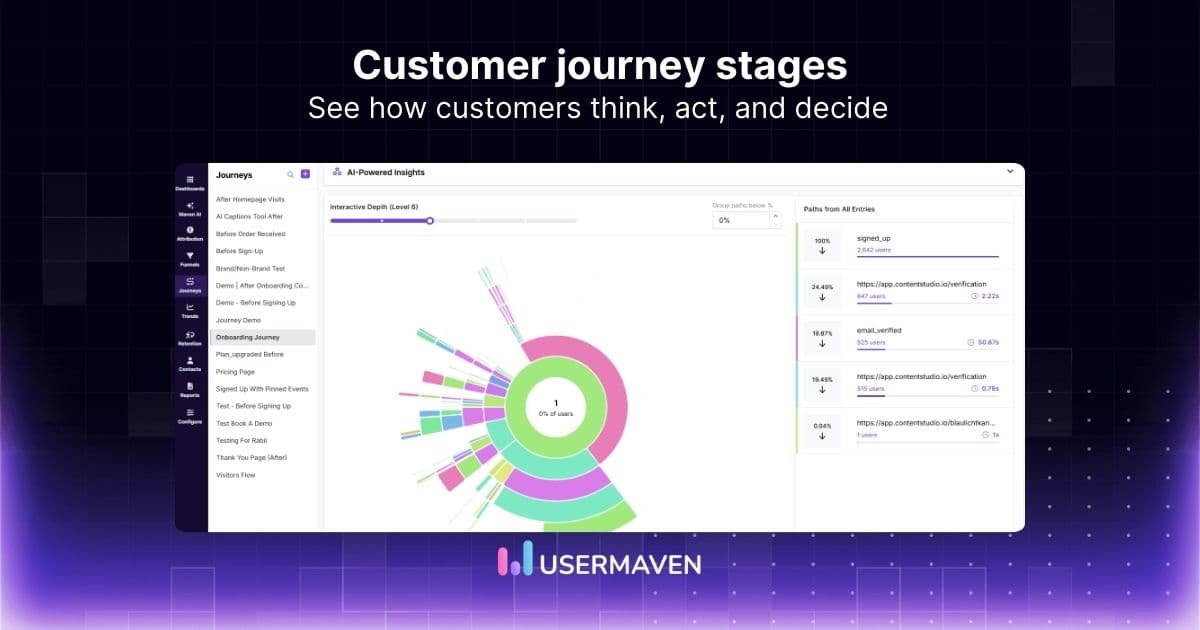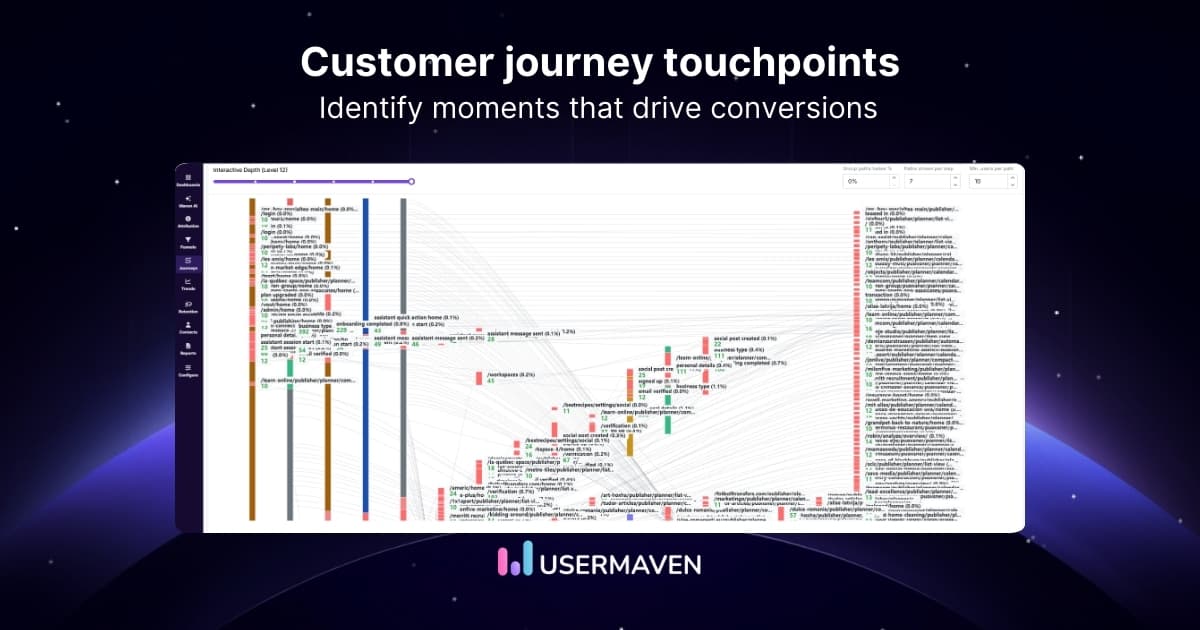Using predictive customer analytics for more conversions
Apr 10, 2023
5 mins read
Written by Usermaven

What if you could use a crystal ball to predict what your customers want and how your product can meet their needs? It would result in increased customer satisfaction, revenue, and competitive advantage. Everything a business looks for!
Adding predictive customer analytics into your business’s toolbox is like having a crystal ball. It offers capabilities for extracting insights from voluminous amounts of data a business generates from different channels. As the name suggests, predictive analytics predicts the future of market trends based on customer behavior.
With this tool, businesses can become more strategic about marketing, product pricing, retention, and customer lifetime value.
In this guide, we’ll explore how predictive customer analytics can be used to increase conversions and drive business growth.
What is predictive customer analytics?
Predictive customer analytics uses data analysis techniques such as machine learning, data mining, algorithm, statistical, and modeling techniques to identify patterns and trends to forecast future customer behavior.
It compliments marketing, sales, and customer services. In short, it impacts the overall business growth.
Based on historical data, purchase history, demographics, social media activity, and website analytics predict how customers will respond to your business in the future.
Businesses can use their understanding of customer behavior to make data-backed decisions to streamline their processes and product life cycles.
Why Is predictive analytics important for businesses?
While predictive analytics uses advanced techniques to predict future behavioral trends, human behavior always has a certain degree of uncertainty and unpredictability. Although it does not guarantee 100% accuracy, predictive analytics can improve customer experience and business decisions.
A study conducted by McKinsey & Company found that companies that utilize big data and analytics show a 5 – 6 % increase in their productivity and profitability. Businesses across various industries that rely on customer data, such as retail & e-commerce, banking & insurance, and telecommunication, utilize predictive customer analytics. Here’s why:
It is the future of customer experience and engagement
With predictive data analysis, you can provide a better customer experience by understanding their preferences and behaviors. These insights lead you to personalize your offerings and craft a more tailored customer experience. Adapting to a proactive approach can result in the timely resolution of customer service-related issues. Overall, a business can enjoy long-term customer loyalty.
For cost-effective decision making
Investing in targeted marketing, sales, and customer support efforts saves businesses from wasting resources on less-effective marketing activities. That is possible with predictive analytics. You can focus your marketing strategy on the most promising leads and retention efforts on churning customers.
Moreover, identifying potential product issues before they occur can minimize emergency repairs. For SaaS businesses, predictive analytics helps companies in scheduled maintenance to avoid downtime, reducing repair costs.
Personalized retention strategies
Early identification of customers at-risk of churning offers the opportunity to reduce churn. Instead of using a one–size–fits–all approach, businesses can create personalized retention strategies.
Addressing issues timely can convert a dissatisfied customer into one with a strong sense of attachment to a business.
Drive conversions
Optimize the customer journey for maximum conversion by determining the key factors and touchpoints that drive conversions. By using segmentation in data, businesses can target customized ads and offer to a specific type of group based on their data.
How does predictive analytics work?
Here’s a simplified breakdown of how it works:
- Data collection, storage & preparation – Data collection and preparation is the foremost step for AI to perform its computations. A tip to remember here is that the larger the data set, the better and more accurate predictions will be. You can collect data from various sources, such as the company website, CRM, social channels, newsletter, surveys, campaigns, etc., stored in archives, databases, and spreadsheets. To avoid manually collecting and storing data, use a data analytics tool like Usermaven, which will track your website’s and product’s insights and save it on a GDPR-compliant cloud-based server.
- Data exploration – Next, a better understanding of the characteristics and relationships in data is acquired with analysis and visualization techniques. This step helps in the selection of the most appropriate model. Analysts then explore data to identify outliers and missing data or resolve any issues before developing models.
- Model development – Depending on the problem and dataset, data scientists develop a predictive model using various tools and techniques. Appropriate variables and algorithms are chosen to ensure the model’s accuracy.
- Model evaluation – The predictive model is tested for accuracy and effectiveness at this stage. Based on the assessment, adjustments are made to the parameters to improve the model’s performance.
- Deployment – After developing and evaluating the predictive model, it is deployed in a production environment. Once integrated into business processes and systems, it can be made available to all stakeholders via a dashboard to make predictions.
5 ways predictive analytics can make customers convert more
Predictive analytics holistically impacts a business processes & operations, refining its marketing, sales, and customer support efforts. Below is a list of ways it boosts conversions.
Predict customer’s needs with segmentation
To predict customer needs, create customer segments. You can segment your audience based on various factors, such as demographics, behavior, or their stage in the customer journey. Here are some ways businesses can use analytics tools like Usermaven to segment their audience and predict customer needs:
- Demographic segmentation: It divides customers into groups based on age, gender, income, education level, and other demographic factors. By understanding different demographic groups’ unique needs and preferences, businesses can tailor their products and marketing messages to better appeal to each group.
- Behavioral segmentation: It divides customers into groups based on their behavior, such as their purchase history, customer interactions with features, website analytics, or social media engagement. By analyzing customer behavior, businesses can predict which products or services are more appealing to certain customers than others and adjust their marketing efforts accordingly.
- Psychographic segmentation: This segmentation divides customers into groups based on their personality traits, values, and lifestyle. By understanding the psychographic profile of every customer segment, businesses can better predict their needs and preferences.
Depending on your business nature, you can use filters to create flexible and sophisticated audience groups. Moreover, Usermaven automatically updates the user segments by adding new people that meet the specified criteria and deleting people that no longer meet the set conditions. It makes your customer segmentation adaptable for a robust marketing strategy.
Get real-time product feedback
Predictive analytics tools can monitor real-time customer feedback and sentiments around different products and services across social media channels. These insights are great for addressing areas of improvement and crafting targeted campaigns. You can also tap into what customers think about certain product features or marketing campaigns with A/B testing.
Another great use of predictive analytics is to develop and analyze customer surveys to gather real-time feedback, unlocking customer pain points, preferences, and behaviors.
Identify content and product gaps
A product naturally becomes more engaging if it speaks to specific customer needs. Instead of feeding your entire audience with the same product messaging, you can become smart in your content marketing with predictive analytics and customer segmentation.
Depending on their stage in the conversion funnel, deliver targeted content over your customer’s most used distribution channels. And better market your products with insights into a particular customer’s problems. Show them how your product meets their needs to move them down the conversion funnel.
Optimize pricing and marketing campaigns
Price sensitivity is one such area since businesses are prone to losing customers with pricing increases. You can identify which customers are sensitive to price changes and which products are most price-sensitive. This information can be crucial for adjusting pricing strategy and maximizing promotions and campaign revenue.
Businesses can set competitive yet profitable pricing reflecting the value of their offering. It is possible by analyzing past sales data and affecting factors for optimal pricing for your products and services. Moreover, businesses can determine the most effective and relevant promotional strategies to boost their conversions, such as discounts, coupons, or loyalty rewards.
Predictive lead scoring
You can refine the lead scoring criteria for identifying leads more likely to convert using predictive algorithms. Customers with high lead scores are prioritized for follow-up, and sales and marketing resources are targeted efficiently to drive them toward conversion. Lead scoring data also helps identify customers who show early signs of churn. Businesses can use this information to develop targeted retention campaigns and minimize customer churn rates.
Grow your business with Usermaven
As discussed, to conduct an accurate predictive analysis, it is important to have sufficient data. By using Usermaven, you can stop worrying about that part of the process because Usermaven tracks visitors’ data with its pixel while labeling technique that bypasses Adblockers. So not only are you collecting data, but you are collecting accurate data that is also privacy-friendly. Here’s what users love about Usermaven:
- Effortless no-code event tracking
- Analyze marketing channels contributing to ROI
- Track user journey to make informed decisions
- Foster product-led growth by a comprehensive view of user behavior within the app
- Accurate analytics with Adblocker bypassing and cookie-less tracking
Request a demo or sign up for free to enjoy simple yet powerful analytics.
With the power of data, companies can extrapolate market trends, improve their product, introduce new, market-competitive products, improve customer retention rates, and reduce churn to help their businesses grow.
See Usermaven in action
Book a free demo and discover how powerful analytics can grow your business.
*No credit card required
FAQs
What can predictive analytics be used for?
Predictive analytics allows various applications across various industries, offering informed decision-making. Common applications include the following:
- Sales and marketing
- Customer retention
- Fraud detection
- Risk management
- Human resources
- Operations and supply chain management
What are the risks of using predictive analytics?
Some of the risks associated with predictive analytics include the following:
- If biases are present in past data, predictive analytics may reflect them.
- Predictive analytics uses personal information, raising privacy and ethical concerns for organizations about violations and misuse.
- Models used in predictive analytics are complex and difficult to understand, creating a lack of transparency.
- Overreliance on technology and automation may miss human oversight.
- Predictive models may miss unforeseen events or environmental changes leading to unrealistic results.
What are the four steps in predictive analytics?
Predictive analytics comprises the following four steps.
- Data collection and preparation – Data is collected from various sources and transformed into a usable format.
- Data analysis and model development – Data is analyzed to identify patterns and develop predictive models using statistical and machine learning techniques.
- Model assessment and deployment – At this point, the model is validated and integrated into existing business processes and systems.
- Monitoring and maintenance – Lastly, the model’s performance is monitored, and necessary adjustments are made.
What are some examples of predictive analytics?
Amazon and Netflix are examples of predictive analytics.
Amazon uses predictive models to upsell and cross-sell with informed product suggestions to individual customers. This recommendation is based on users’ browsing and purchase history, showing products that might be valuable in addition to their purchases. Those selling on Amazon can benefit from these insights by aligning their product offerings with customer preferences to boost visibility and sales.
Netflix has an AI AI-powered algorithm that makes predictions using watch & search history, demographics, and other factors. According to a survey, Netflix’s recommendation algorithm influenced 75 – 80 % of the user activity.
Try for free
Grow your business faster with:
- AI-powered analytics & attribution
- No-code event tracking
- Privacy-friendly setup


